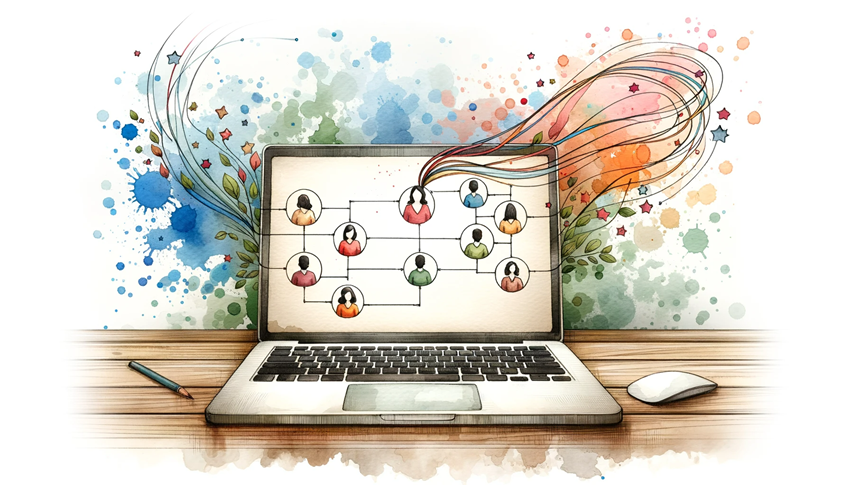Services List
Understanding your customer's journey is critical for any company that wants to provide a tailored and effective service. Personas allow you to sketch out these journeys in a more targeted manner. This post will walk you through the process of generating persona-based customer journey maps, which are an important tool for increasing customer happiness and driving business success.

Covered in this article
What Are Customer Journey Maps?
Steps to Create a Persona-Based Customer Journey Map
Benefits of Persona-Based Customer Journey Maps
The Power of Data Analytics in Customer Journey Mapping
Wrapping Up the Journey: The Final Takeaways
What Are Customer Journey Maps?
Customer journey maps are visual representations that outline the steps a customer goes through when interacting with a business. These maps can cover various touchpoints, from initial awareness to the final purchase and beyond.
Why Use Personas?
Personas are semi-fictional characters that represent your ideal customers. By using personas in your customer journey maps, you can:
- Identify specific needs and pain points for different customer segments
- Tailor marketing strategies more effectively
- Enhance customer engagement by offering personalised experiences.
Steps to Create a Persona-Based Customer Journey Map
Step 1: Research and Create Personas
Before you can map out the customer journey, you need to know who your customers are. Conduct market research to gather data on customer demographics, behaviour, and preferences. Use this data to create detailed personas.
Step 2: Identify Touchpoints
List all the possible points of interaction between the customer and your business. These could include your website, social media channels, customer service, and physical stores.
Step 3: Map Out the Customer Journey for Each Persona
For each persona, outline the steps they would take at each touchpoint. Consider their goals, challenges, and emotions at each stage.
Example Table: Customer Journey for Persona "Tech-Savvy Tina":
| Stage | Touchpoint | Goal | Challenges | Emotions |
|---|---|---|---|---|
| Awareness | Google Search | Find a reliable tech product | Overwhelmed by choices | Curious, overwhelmed |
| Consideration | Social Media | Compare reviews | Trusting online reviews | Interested, cautious |
| Purchase | E-commerce Website | Complete Purchase | Navigating the website | Excited, impatient |
| Post-Purchase | Seek product support | Finding customer service info | Relieved, expectant |
Step 4: Validate and Refine
Once the initial map is created, validate it by gathering real customer feedback. Use this information to refine your map and make it more accurate.
Benefits of Persona-Based Customer Journey Maps
- Targeted Marketing: Tailor your marketing efforts to specific customer segments.
- Improved Customer Experience: Understand and address the unique needs of different personas.
- Increased ROI: By focusing on the most profitable customer segments, you can allocate resources more efficiently.
The Power of Data Analytics in Customer Journey Mapping
In an era where data is often termed the 'new oil,' leveraging data analytics in customer journey mapping can provide a competitive edge. Data analytics not only quantifies customer interactions but also offers actionable insights that can significantly improve customer experience.
Types of Data to Collect
When it comes to customer journey mapping, various types of data can be useful:
- Behavioural Data: This includes click-through rates, time spent on a page, and other actions taken by the customer on your digital platforms.
- Transactional Data: Purchase histories, cart abandonment rates, and other transaction-related data fall under this category.
- Feedback Data: Customer reviews, surveys, and direct feedback provide qualitative insights into customer satisfaction and areas for improvement.
Integrating Analytics Tools
There are several analytics tools available that can help you collect and interpret this data. Google Analytics, Adobe Analytics, and custom-built solutions can track a wide range of metrics. The key is to integrate these tools seamlessly into your customer journey mapping process for real-time data tracking and analysis.
Benefits of Data-Driven Customer Journey Maps
Utilising data analytics in your customer journey mapping offers several advantages:
- Precision: Data analytics allows for a more precise understanding of how customers interact with your business at each touchpoint.
- Proactivity: Real-time data enables you to proactively address issues before they escalate, improving customer satisfaction.
- Personalisation: With data insights, you can create highly personalised experiences for different customer personas, thereby increasing engagement and loyalty.
Case in Point: Velocity's Success with Data Analytics
At Velocity, we have successfully integrated data analytics into our customer journey mapping services. This has enabled us to identify key performance indicators (KPIs) for our clients in the technology, energy, real estate, and education industries. As a result, our clients have seen measurable improvements in customer engagement and ROI.
Wrapping Up the Journey: The Final Takeaways
Creating persona-based customer journey maps is an invaluable strategy for any business looking to improve customer experience and drive growth. It allows you to understand your customer's needs, preferences, and pain points, enabling you to offer a more personalised and effective service.
Ready to take your customer experience to the next level? Contact Velocity for expert guidance on creating effective persona-based customer journey maps. Alternatively, sign up for our newsletter to stay updated on the latest trends and insights in digital marketing.




